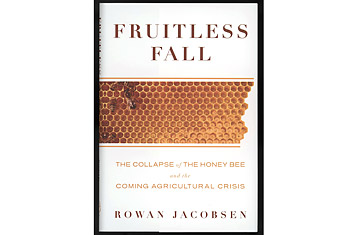
Fruitless Fall by Rowan Jacobsen.
By Rowan Jacobsen
Bloomsbury; 279 pp.
The Gist:
By exploring the mysterious phenomenon of Colony Collapse Disorder (CCD) that is wiping out honey bees worldwide, Jacobsen
lays out a case for why we need to care — and it has very little to do
with honey. A spiritual successor to Rachel Carson's seminal eco-polemic Silent Spring, Fruitless Fall
walks us through the various theories put forth as causes of CCD —genetically-modified crops, global warming, God's wrath, cellular phones,
loss of habitat and a nicotine-like pesticide to name a few. Jacobsen concludes that a return to simpler times — for example, before honey bees were pumped full corn syrup and bred to pollinate monocrops from California to Florida — may be the only answer to the decimation of these vital insects, upon which our food supply depends.
Highlight Reel:
1. On the "waggle dance" that a nectar-gathering honeybee does in the
hive to alert others that there's an orange tree nearby: "She heads to
the dance floor and does her waggle dance for the spectators, running up and
down the comb while wiggling her butt and buzzing. The angle she
runs ... corresponds to the angle from the sun of the path that will lead
directly to the orange tree. The duration of the waggle dance tells other
bees how far to go — loosely, three quarters of a mile per second of
waggling."
2. On what Pennsylvania's state beekeeper Dennis vanEngelsdorp found when he examined victims of CCD: "[W]hat he saw looked like an infinitesimal World War I battlefield. Everywhere was shiny, pockmarked ruin. The bees' guts, which should have been white, were stippled brown with infection. Their sting glands had blackened — a melanization last reported fifty years ago in connection with rare fungal infections. VanEngelsdorp found deformed wing virus, black queen cell virus, and many more. The bees didn't have one disease. They had them all."
3. On what a "hive mind" — the highly organized honey bee hierarchy — looks like when it's suffering from CCD: "There were usually a few bees, yes, but they were wandering without purpose like survivors of an apocalyse, which they were ... Great lobes of the hive mind had died, and what bits remained had lost any organizing principle. If this was a mind, it was one with advanced Alzheimer's disease."
4. A typically stressful day for a honey-bee, in terms human hive-dwellers can understand: "You stagger off a coast-to-coast red-eye flight and chug a Pepsi for breakfast to revive. You hop in your rental car and head for your business meeting, but wouldn't you know it, the GPS is malfunctioning in the car and you get lost. You show up for the meeting late, edgy, and shaking. You have to excuse yourself to hit the bathroom because you've got a stomach bug and antibiotics just aren't helping. Not to mention the fleas that seem to be leaping from the carpet into your socks. Halfway through the meeting a pest-control guy steps in and sprays the room with a white fog that makes you retch."
The Lowdown:
You can't finish this book unconvinced that our food supply is in serious
danger. Although Jacobsen doesn't solve the CCD mystery, he presents ample
evidence that the current state of affairs — "rented" honey bees that are shipped coast to coast to pollinate crops — is unsustainable and stressing the insects to the max. Pointing out that 80% of our food relies on pollination at some point in its
life cycle, Jacobsen's concern for the fate of the honey bee population
is easily contagious. He offers the same prescription as most authors
writing about our modern food supply — it's past time to go local and organic over imported
and conventional. But he has one more piece of advice: appreciate, don't
shun, the honey bee, for it is the "landscape architect of the American
pastoral."
The Verdict: Read
